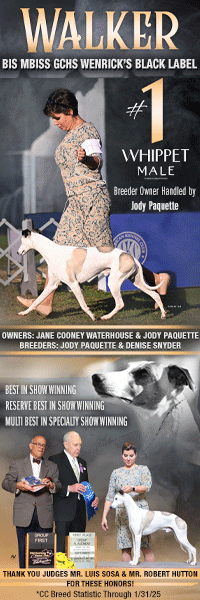From The CC Vault: A Certain Competence Level
By Dr. Gareth Morgan-Jones
Originally Published September 2012
 During the course of a recent show weekend when I was on a panel with one of our senior and most distinguished judges, who also happens to be a very good friend of mine, occasion arose to discuss over dinner the current state of our sport and what some see as among the more significant and most readily apparent shortcomings. We also, of course, considered the many positive aspects. The subject of the highly uneven quality of judging came up, with said individual expressing the strong opinion that this is rapidly becoming one of our most critical problems at the present time. We talked about causes and effects in this context. The why and wherefore of it all. Quite obviously this is an area which is fraught with variables with the singular, most notable deficiencies presumably arising from lack of adequate knowledge, appropriate experience, and sufficient preparation. My companion suggested that a trend toward more cursory, superficial, generic judging may well now be in play and that this is a view which is seemingly held by many. With changing generations and values there may well be an element of truth to this. There have been cultural changes and the manner of preparation has undergone alteration. A compromising of that which is substantive is frequently evident. Preparedness clearly differs a great deal and hence the resulting level of competence. Learning curves do, of course, vary considerably and the ability to effectively and intelligently apply acquired knowledge obviously differs among individuals. Translating that which is learned by seminar attendance, or participation in hands-on practicums, or undergoing ringside observations, however good those educational exercises might be, is something that is going to vary from person to person. So reasoned my friend.
During the course of a recent show weekend when I was on a panel with one of our senior and most distinguished judges, who also happens to be a very good friend of mine, occasion arose to discuss over dinner the current state of our sport and what some see as among the more significant and most readily apparent shortcomings. We also, of course, considered the many positive aspects. The subject of the highly uneven quality of judging came up, with said individual expressing the strong opinion that this is rapidly becoming one of our most critical problems at the present time. We talked about causes and effects in this context. The why and wherefore of it all. Quite obviously this is an area which is fraught with variables with the singular, most notable deficiencies presumably arising from lack of adequate knowledge, appropriate experience, and sufficient preparation. My companion suggested that a trend toward more cursory, superficial, generic judging may well now be in play and that this is a view which is seemingly held by many. With changing generations and values there may well be an element of truth to this. There have been cultural changes and the manner of preparation has undergone alteration. A compromising of that which is substantive is frequently evident. Preparedness clearly differs a great deal and hence the resulting level of competence. Learning curves do, of course, vary considerably and the ability to effectively and intelligently apply acquired knowledge obviously differs among individuals. Translating that which is learned by seminar attendance, or participation in hands-on practicums, or undergoing ringside observations, however good those educational exercises might be, is something that is going to vary from person to person. So reasoned my friend.
As I have suggested in a previous essay published in The Canine Chronicle, the aptitude and facility to judge pedigreed dogs well is directly derived from depth of background, knowledge and experience. Each individual who fulfills this function at our shows has, ideally, to undergo a continuing process of learning in order to reach a certain level of evaluative proficiency and, hence, competency. We are talking sufficiency of means to accomplish something specific here. A certain measure of mental sophistication has to be in place. A certain connoisseurship is practiced. Possession of a certain awareness is a necessity. Ultimately, the ability to make clean and valid decisions comes from practice, provided that the necessary ingredients, in terms of knowledge possession, are present in adequate quantity. As they say, there is no substitute for experience in this regard and there is a certain cumulative effect in play. The facility, the capacity and quality of being easily performed, only comes with time. It is surely not something which can be rushed. Those who are hell bent on being approved for more and more breeds in the least amount of time should perhaps on occasion pause and try to adopt a more realistic and responsible perspective. As I noted in my essay in last month’s issue of this magazine, every judge has a so-called comfort zone when it comes to individual breeds and unless such is present in good measure judging can readily become akin to somewhat unworthy groveling in the dark. In such circumstances, it is the exhibitors who unfairly suffer and, thereby, so eventually does the sport. One other thing: as I have written before, when a person allows confidence to run way ahead of his or her competence problems inevitably arise.
Some intangibles are, of course, involved in all of this. The asset of becoming a respected judge comes about, if not exactly circuitously, certainly along a lengthy, winding path. It is not always easy. There are numerous bumps along the way. The process of acquiring a sufficiently adequate and essential ‘feel’ for a particular breed to judge it really well is never as simple nor as straightforward as one might think. There is a whole lot involved; there is a refined subtlety in play. It is a sometimes elusive, not readily acquired, skill. To be successful one has to work really hard at it! Having a so-called ‘eye for a dog’ is all well and good but there is much more to it than that. That is actually only the beginning. As I’ve suggested above, a certain measure of sophistication has to be developed by active pursuit and conscious nurturing. A certain passion provides the mental fuel. A certain talent is also surely involved. We are talking here about such things as aptitude, disposition, intelligence, mental acuity, keenness of perception; all those natural endowments of a person. If some of these are lacking to some degree, difficulties will inevitably arise. The initial task involves the acquisition of basic knowledge of those characteristics which make each breed unique. Then comes the more difficult challenge of applying this information effectively when confronted with reality in the show ring. Each breed presents its own set of peculiarities and it is, of course, critical that judges be fully aware of them. Unfortunately this does not always seem to be the case.
Let me give you an example of what I mean. At a show in the Pacific northwest, a few weeks ago, a well-respected, high-profile, extremely-successful professional handler came up to me, after I had completed judging a particular breed, and made the following rather seminal remark ‘I just want you to know that, in my opinion, you are one of the few judges who have a real handle on this breed’. I considered this to be a considerable and most generous compliment since I had just beaten the ‘special’ which he is currently campaigning and had not even awarded it a Select. (Pardon me if this sounds like I’m blowing my own trumpet: be assured that this is not my intent at all). I mention this only to make a particular point. Now it so happens that I have a long-time familiarity with this breed and am perfectly aware of the fact that judges are, unfortunately, all over the place with it. It is admittedly a rather tricky entity to judge because it has certain peculiarities which are highly unique and make it very different from most others. Moreover, there is a whole lot of variation within it and many breeders do not appear to be making a concerted effort to critically select and breed according to the dictates of the standard, which is pretty explicit in terms of such things as proportion. It is perfectly obvious that many judges are ill-prepared to judge this breed, have no understanding of its essence, and hence a sort of quagmire, a hopeless (if this be the right word) muddle and tangle, has been reached. If judges continue putting up dogs which do not match the requirements specified in the breed’s standard, the current mess will surely continue: and so it goes.
As new breeds are added, judges are confronted with the need to smoothly integrate new knowledge into a pre-existing body of information and to do so as seamlessly as possible without disrupting or throwing the mind into disorder. Again, this is not altogether straightforward for there is always a danger of certain mental baggage compromising one’s ability to look at exhibits in proper, breed-specific, perspective. Failure to do so can lead to generic judging of the worse sort. A few short years ago I was told of a judge (a relative newbie and a know-it-all at that) making the following rather absurd remark after beating one of the greatest Pekingese of all time in Breed competition: ‘His rear didn’t feel quite right to me’. Well hello! Did we forget that soundness is relative: that achondroplastic dwarfs are never as structurally well-made as normally developed animals, in dogs or in humans for that matter? With respect: where was this lady’s head at? She’s presumably still out there judging the breed. Such insensitivity to reality boggles the mind. But this illustrates as well as anything the need to develop that all-important perspective, that awareness, that special ‘feel’ (as well as respect) for a breed. This is hard to describe but without it things can come out pretty messily. In the absence of such, the process can readily translate into highly generic and mindless fault-judging becomes more prevalent. There is always, of course, a challenge in setting a balance and to not overly-emphasize one aspect or another. As I’ve said before, on a number of occasions, making appropriate trade-offs between structurally-better-made exhibits versus those that possess superior breed ‘type’ requires skill and mental dexterity. Prioritization is never an easy undertaking in this context and one has to be willing and ready to make calls incisively. Those are the highly difficult decisions which oftentimes have to be made. That is why a high level of competence requires a great amount of knowledge and experience. There are no substitutes. There are no shortcuts.
Short URL: https://caninechronicle.com/?p=261187
Comments are closed












